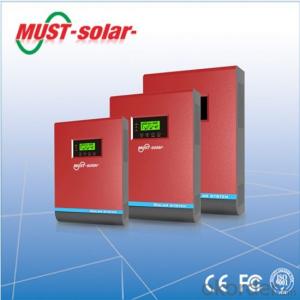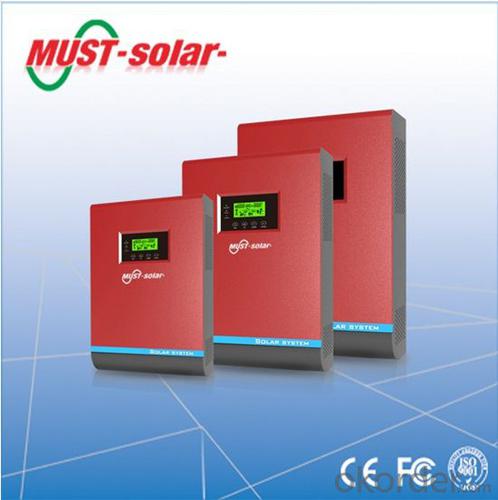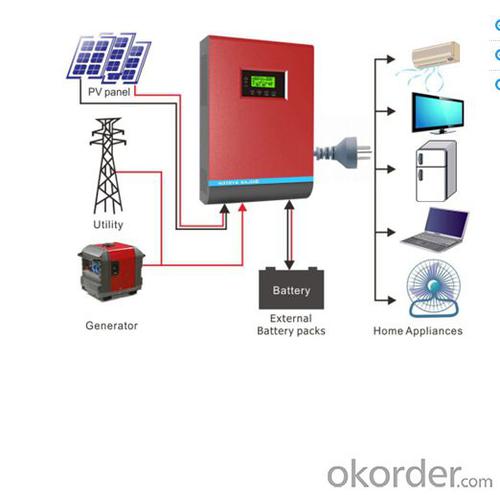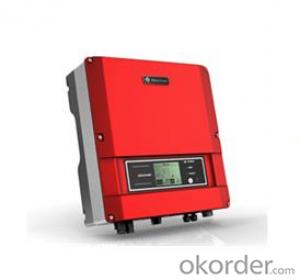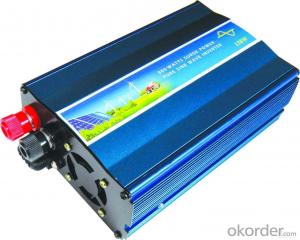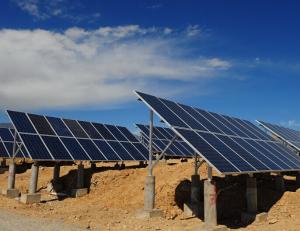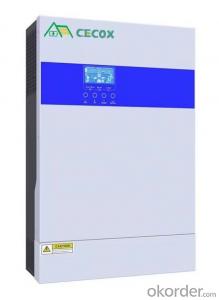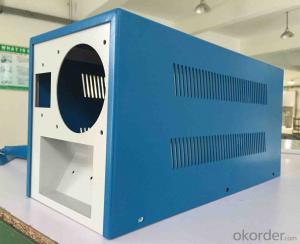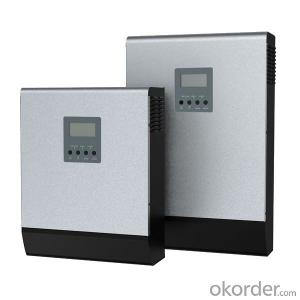Solar Inverter 1kw Off Grid 1kVA-5kVA Built-in 50APwm 60Amppt Charge Controller Parallel Function
- Loading Port:
- China main port
- Payment Terms:
- TT or LC
- Min Order Qty:
- 1500 watt
- Supply Capability:
- 3000000 watt/month
OKorder Service Pledge
OKorder Financial Service
You Might Also Like
1. Structure of Solar Inverter Off Grid 1kva -5kva Built in 50APWM 60AMPPT Charge Controller Parallel Function Description
A solar inverter, or PV inverter, or Solar converter, converts the variable direct current (DC) output of a photovoltaic (PV) solar panel into a
utility frequency alternating current (AC) that can be fed into a commercial electrical grid or used by a local, off-grid electrical network. It is
a critical BOS–component in a photovoltaic system, allowing the use of ordinary AC-powered equipment. Solar inverters have special
functions adapted for use with photovoltaic arrays, including maximum power point tracking and anti-islanding protection.
2. Main Features of Solar Inverter Off Grid 1kva -5kva Built in 50APWM 60AMPPT Charge Controller Parallel Function
• Pure sine wave inverter
• Selectable input voltage range for home appliances and personal computers
• Selectable charging current based on applications
• Configurable AC/Solar input priority via LCD setting
• Compatible to mains voltage or generator power
• Parallel operation with up to 4 units only available for PV200 4KVA/5KVA
• Auto restart while AC is recovering
• Overload and short circuit protection
• Smart battery charger design for optimized battery performance
• Cold start function
3. Solar Inverter Solar Inverter Off Grid 1kva -5kva Built in 50APWM 60AMPPT Charge Controller Parallel Function Images
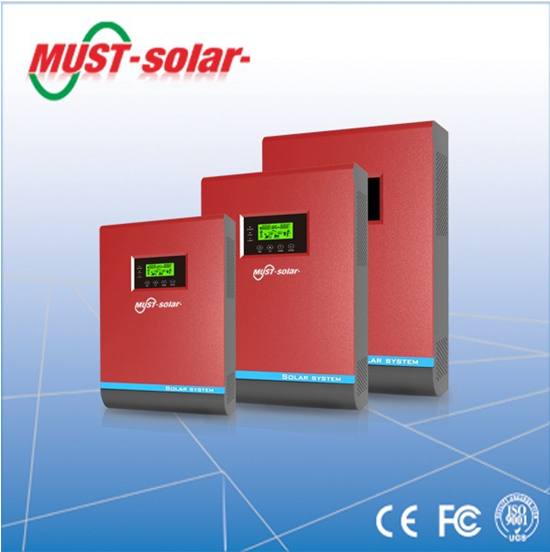
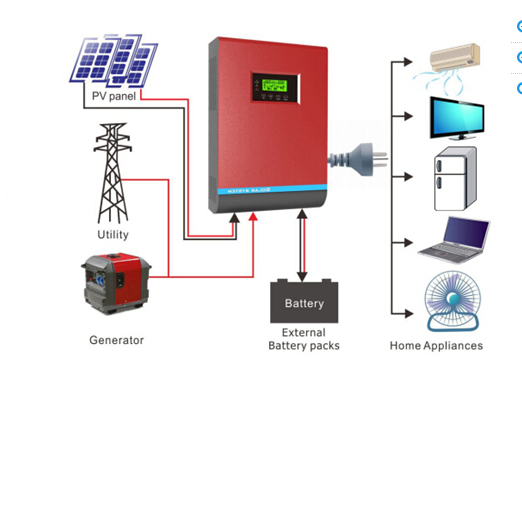
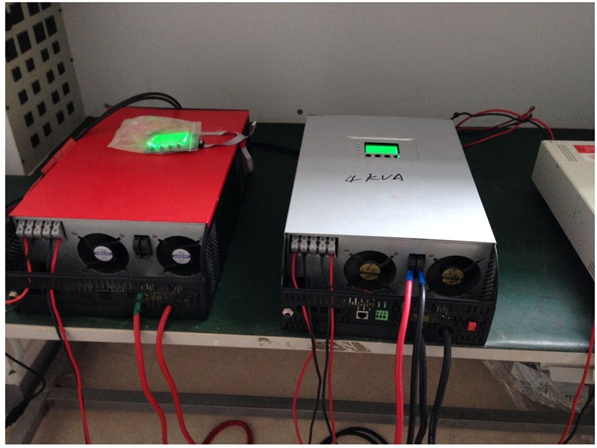

4. Solar Inverter Off Grid 1kva -5kva Built in 50APWM 60AMPPT Charge Controller Parallel Function Specification
RATED POWER | 1000VA / 800W | 2000VA/ | 3000VA / 2400W | 4000VA / 3200W | 5000VA / 4000W |
1600W | |||||
INPUT | |||||
Voltage | 230 VAC | ||||
Selectable Voltage Range | 170-280 VAC (For Personal Computers) ; 90-280 VAC (For Home Appliances) | ||||
Frequency Range | 50 Hz/60 Hz (Auto sensing) | ||||
OUTPUT | |||||
AC Voltage Regulation | 230 VAC ± 5% | ||||
(Batt. Mode) | |||||
Surge Power | 2000VA | 4000VA | 6000VA | 8000VA | 10000VA |
Efficiency (Peak) | 90% | 93% | |||
Transfer Time | 10 ms (For Personal Computers) ; 20 ms (For Home Appliances) | ||||
Waveform | Pure sine wave | ||||
BATTERY | |||||
Battery Voltage | 12 VDC | 24 VDC | 48 VDC | ||
Floating Charge Voltage | 13.5 VDC | 27 VDC | 54 VDC | ||
Overcharge Protection | 15 VDC | 30 VDC | 60 VDC | ||
Maximum Charge Current | 10 A or 20 A | 20 A or 30 A | 60 A | ||
SOLAR CHARGER (OPTION) | |||||
Charging Current | 50 A | ||||
Maximum PV Array Open Circuit Voltage | 30 VDC | 60 VDC | 105 VDC | ||
Standby power Consumption | 1 W | 2 W | 2 W | ||
PHYSICAL | |||||
Dimension, D x W x H (mm) | 95 x 240 x 316 | 100 x 272 x 355 | 125 x 297.5 x 468 | ||
Net Weight (kgs) | 5 | 6.4 | 6.9 | 9.8 | 9.8 |
OPERATING ENVIRONMENT | |||||
Humidity | 5% to 95% Relative Humidity(Non-condensing) | ||||
Operating Temperature | 0°C - 55°C | ||||
Storage Temperature | -15°C - 60°C | ||||
5. FAQ of Solar Inverter Off Grid 1kva -5kva Built in 50APWM 60AMPPT Charge Controller Parallel Function
Q1:Can we visit your factory?
A1:Sure,welcome at any time,seeing is believing.
Q2:Which payment terms can you accept?
A2:T/T,L/C,Moneygram,Paypal are available for us.
- Q: Are there any government regulations or certifications for solar inverters?
- Yes, there are government regulations and certifications for solar inverters. In many countries, solar inverters must comply with specific standards and regulations set by government bodies. Additionally, various certifications such as International Electrotechnical Commission (IEC) standards, UL listing, and CE marking are commonly required to ensure the safety, performance, and interoperability of solar inverters.
- Q: What is the role of a solar inverter in maximizing solar panel output?
- The role of a solar inverter in maximizing solar panel output is to convert the direct current (DC) generated by the solar panels into alternating current (AC) which can be used to power electrical devices in homes or businesses. The inverter ensures that the AC output is synchronized with the grid's frequency and voltage, allowing for efficient and effective utilization of solar energy. Additionally, the inverter also helps in monitoring and optimizing the performance of the solar panels, ensuring that they operate at their maximum efficiency and produce the highest possible output.
- Q: How does a solar inverter handle varying solar irradiance levels?
- A solar inverter handles varying solar irradiance levels by continuously monitoring the incoming solar power and adjusting its output accordingly. It employs a maximum power point tracking (MPPT) algorithm that optimizes the energy conversion from the solar panels to the desired AC power output. When solar irradiance levels fluctuate, the inverter dynamically adapts to ensure the maximum power is extracted from the solar panels. This allows for efficient energy conversion and maximum utilization of the available solar power.
- Q: What is the typical lifespan of the capacitors in a solar inverter?
- The typical lifespan of capacitors in a solar inverter can vary depending on various factors such as the quality of the capacitors, operating conditions, and maintenance practices. However, on average, capacitors in a solar inverter are expected to have a lifespan of around 10 to 15 years.
- Q: How does a solar inverter handle variations in grid frequency?
- A solar inverter handles variations in grid frequency by continuously monitoring the frequency of the grid and adjusting its own output accordingly. If the grid frequency increases, the inverter decreases its output to maintain a stable supply. Conversely, if the grid frequency decreases, the inverter increases its output to compensate for the drop. This enables the solar inverter to synchronize with and support the grid, ensuring a reliable and stable power supply.
- Q: How does a solar inverter prevent reverse current flow?
- A solar inverter prevents reverse current flow by using a specialized circuitry called anti-islanding protection. This circuitry constantly monitors the grid and disconnects the solar system from it when it detects a drop in voltage or a power outage. This ensures that any excess energy generated by the solar panels does not flow back into the grid, preventing potential damage to the system and protecting utility workers during maintenance or repairs.
- Q: What is the importance of insulation resistance measurement in a solar inverter?
- Insulation resistance measurement in a solar inverter is crucial as it helps ensure the safety and efficiency of the electrical system. By measuring the insulation resistance, any potential faults or deteriorations in the insulation can be detected, preventing electrical leakage or short circuits. This measurement also helps identify any insulation breakdowns that may compromise the performance and reliability of the solar inverter. Ultimately, insulation resistance measurement is essential for maintaining the integrity of the solar inverter and ensuring the safety of both the electrical system and the people using it.
- Q: Can a solar inverter be used in three-phase systems?
- Yes, a solar inverter can be used in three-phase systems. In fact, there are specific three-phase solar inverters designed to convert the DC power generated by solar panels into AC power for utilization in three-phase electrical systems. These inverters are capable of efficiently managing the power flow and ensuring balanced distribution across all three phases.
- Q: Can a solar inverter be connected to a home automation system?
- Yes, a solar inverter can be connected to a home automation system. This integration allows for better control and monitoring of the solar energy production and enables homeowners to optimize their energy usage based on real-time data.
- Q: What is the difference between a string inverter and a microinverter?
- The main difference between a string inverter and a microinverter lies in the way they convert direct current (DC) from solar panels to alternating current (AC) for use in homes or businesses. A string inverter is a centralized device that connects multiple solar panels in a series or "string" configuration. It converts the combined DC power from the entire string into AC power. This means that if one panel in the string underperforms or is shaded, it can affect the overall performance of the entire string. On the other hand, a microinverter is a small inverter that is attached to each individual solar panel. It converts the DC power from each panel into AC power independently. This allows each panel to perform optimally, even if others in the system are shaded or experiencing issues. In summary, while a string inverter handles the conversion of power from multiple panels as a whole, a microinverter ensures each panel operates at its maximum potential independently.
Send your message to us
Solar Inverter 1kw Off Grid 1kVA-5kVA Built-in 50APwm 60Amppt Charge Controller Parallel Function
- Loading Port:
- China main port
- Payment Terms:
- TT or LC
- Min Order Qty:
- 1500 watt
- Supply Capability:
- 3000000 watt/month
OKorder Service Pledge
OKorder Financial Service
Similar products
Hot products
Hot Searches
Related keywords
